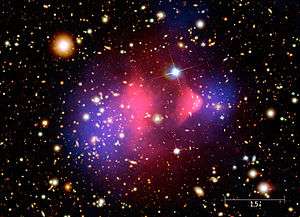Bullet Galaxy
The Bullet Galaxy (RXC J2359.3-6042 CC) is a galaxy in the galaxy cluster RXC J2359.3-6042 (Abell 4067 or ACO 4067). The Bullet Galaxy is the sole component of one half of a cluster merger between the bulk of the cluster and this galaxy, which is plowing through the cluster, similar to how merging clusters Bullet Cluster and Bullet Group have merged. Unlike those two mergers, the Bullet Galaxy's merger is between one galaxy and a galaxy cluster. The cluster merger is happening at a lower speed than the Bullet Cluster, thus allowing the core of the Bullet Galaxy to retain cool gas and remain relatively undisturbed by its passage through the larger cluster. This cluster merger is the first one observed between a single galaxy and a cluster. The galaxy and cluster lies at redshift z=0.0992, some 1.4×109 ly (4.3×108 pc) away. The galaxy is traveling through the cluster at a speed of 1,310 km/s (2,900,000 mph).[1][2][3][4]
| Bullet Galaxy | |
|---|---|
 Bullet Cluster | |
| Observation data (J2000.0 epoch) | |
| Right ascension | 23h 59.3m |
| Declination | −60° 42′ |
| Redshift | 0.096 |
| Distance | 1.3 Gly (400 Mpc) |
| Group or cluster | ACO 4096 |
| Other designations | |
| Bullet Galaxy, RXC J2359.3-6042 CC, ACO 4067 CC, Abell 4067 CC, A 4067 CC | |
By studying this unique merging researchers can gain insight on dark matter, and how it interacts with other objects in space. According to astrophysicists James Bullock, "Galaxy clusters that are merging with each other represent interesting laboratories for this kind of question,” when he was speaking of dark matter and the Bullet cluster.
Bullet Cluster

The Bullet Cluster (1E 0657-558) consists of two colliding clusters of galaxies. Strictly speaking, the name Bullet Cluster refers to the smaller sub cluster, moving away from the larger one. It is at a co-moving radial distance of 1.141 Gpc (3.7 billion light-years). Gravitational lensing studies of the Bullet Cluster are claimed to provide the best evidence to date for the existence of dark matter. Observations of other galaxy cluster collisions, such as MACS J0025.4-1222, are similarly claimed to support the existence of dark matter.[5]
References
- George Dvorsky (15 January 2015). "A "Bullet" Galaxy Is Piercing Through Other Galaxies At Ludicrous Speed". io9.
- Dan Vergano (16 January 2015). "Astronomers Spy "Bullet" Galaxy Blasting Through Other Galaxies". National Geographic.
- Gayoung Chon, Hans Boehringer (10 January 2015). "Witnessing a merging bullet being stripped in the galaxy cluster, RXCJ2359.3-6042". Astronomy & Astrophysics (published February 2015). 574: 5. arXiv:1501.02371. Bibcode:2015A&A...574A.132C. doi:10.1051/0004-6361/201425143. A132.
- Marisa Lewis (15 January 2015). "'Bullet' Galaxy Hints At Proof Of Dark Matter, Will Help To Answer Questions About Mass Of Distant Galaxies [PHOTO]". KpopStarz.
- "Your NED Search Results". ned.ipac.caltech.edu. Retrieved 2018-03-20.